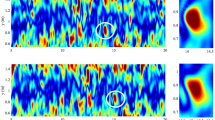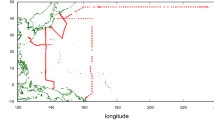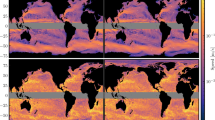Summary
Networks of closely spaced hydrographic stations are used to calculate the structure function for the depths of the 20° isotherm over distances between 40 and 1400 kilometers. In the central North Pacific Ocean the 20° isotherm is situated near the center of the thermocline and these spectra have a typical peak near 200 kilometers, which is related to large geostrophic eddies of corresponding dimensions. The remainder of each spectrum increases monotonically in the range 400 to 1400 kilometers. There are appreciable differences between the spectra obtained on different cruises. In contrast to the spectra of the thermocline, the spectra of the mixed-layer depth often remain flat between 400 and 1400 kilometers, indicating that all energy is contained in fluctuations of small scale. These spectra show the inherent irregularities in the thermal structure of the ocean and are valuable for assessing the accuracy of predictions of thermal structure. The computed spectra cover the gap between ordinary turbulence and the large-scale ocean circulation, and show that turbulent energy is continuously distributed over the entire range from 50 meters to 1400 kilometers.
Zusammenfassung
Netze dicht zusammenliegender hydrographischer Stationen werden benutzt, um die analytische Funktion für die Tiefen der 20°-Isotherme zwischen 40 und 1400 km zu berechnen. Im Zentralteil des Nordpazifiks liegt die 20°-Isotherme fast in der Mitte der thermischen Sprungschicht; diese Spektren haben ein typisches Maximum bei 200 km in Verbindung mit großen geostrophischen Wirbeln entsprechenden Ausmaßes. Das restliche Spektrum steigt im Bereich von 400–1400 km monoton an. Verschiedene Fahrten haben erheblich unterschiedliche Spektren ergeben. Im Gegensatz zu den Spektren der thermischen Sprungschicht bleiben die Spektren der Mischschichttiefe zwischen 400 und 1400 km oft flach und deuten an, daß alle Energie in kleinmaßstäbigen Schwankungen enthalten ist. Diese Spektren zeigen die Unregelmäßigkeiten im thermischen Aufbau des Meeres und sind für die Genauigkeit der Vorhersagen über den thermischen Aufbau von besonderer Bedetung. Die berechneten Spektren schließen die Lücke zwischen gewöhnlicher Turbulenz und der großmaßstäbigen ozeanischen Zirkulation und zeigen, daß die turbulente Energie ständig über den gesamten Bereich von 50–1400 km verteilt wird.
Résumé
Des réseaux de stations hydrographiques rapprochées sont utilisés pour calculer la fonction structurale relative aux profondeurs de l'isotherme de 20° sur des distances comprises entre 40 et 1400 kilomètres. Dans la partie centrale de l'Océan Pacifique Nord, l'isotherme de 20° est située près du centre de la thermocline et ces spectres ont une pointe caractéristique aux environs de 200 kilomètres, ce qui est lié à de vastes tourbillons géostrophiques de dimensions correspondantes. Le reste de chaque spectre augmente de façon monotone dans l'intervalle de 400 à 1400 kilomètres. Ily a des différences sensibles entre les spectres obtenus au cours de différentes croisières. Par opposition aux spectres de la thermocline, ceux à la profondeur de la couche de mélange, offrent souvent un méplat entre 400 et 1400 kilomètres, ce qui montre que toute l'énergie est contenue dans des fluctuation à petite échelle. Ces spectres font apparaître les irrégularités inhérentes dans la structure thermique de l'océan et contribuent utilement à la précision des prévisions de structure thermique. Les spectres calculés comblent la coupure entre turbulence ordinaire et circulation océanique à grande échelle; ils montrent aussi que l'énergie de turbulence est continuellement répartie sur toute l'étendue comprise entre 50 mètres et 1400 kilomètres.
Similar content being viewed by others
References
Black, C. F., 1965: The turbulent distribution of temperature in the ocean. Santa Monica, Calif.: Bissett-Berman Corporation. 171 pp. (Rep. Off. Naval Res.)
Fuglister, F. C. and L. V. Worthington, 1951: Some results of a multiple ship survey of the Gulf Stream. Tellus3, 1.
Ichiye, T. and F. C. W. Olson, 1960: Über die neighbour diffusivity im Ozean. Dt. hydrogr. Z.13, 13.
Joseph, J. and H. Sendner, 1958: Über die horizontale Diffusion im Meer. Dt. hydrogr. Z.11, 49.
Kolmogrov, A. N., 1941: The local structure of turbulence in incompressible viscous fluid for very large Reynold's Numbers. [In Russ.] Dokl. Akad. Nauk SSSR.30, 299.
LaFond, E. C. and K. G. LaFond, 1966: Vertical and horizontal thermal structures in the sea. NEL Rep. U. S. Navy Electronics Lab., San Diego, Calif. No 1395, 138 pp.
Ozmidov, R. V., 1965: On the energy distribution between oceanic motions of different scales [In Russ.] Izv. Akad. Nauk SSSR, Fiz. Atmosf. Okeana.1, 439.
Weizsaecker, C. F. v., 1948: Das Spektrum der Turbulenz bei großen Reynoldsschen Zahlen. Z. Phys.124, 614.
Wyrtki, K., J. B. Burks, R. C. Latham [et al.], 1967: Oceanographic observations during 1965–1967 in the Hawaiian Archipelago. Rep. Hawaii Inst. Geophys. Univ. Hawaii. Honolulu. No 67-15, 150 pp.
Additional information
Hawaii Institute of Geophysics Contribution No. 219.
Nach einem Vortrag, gehalten während der IAPSO-Tagung in Bern 1967 im “Symposium on turbulence in the ocean”.
Rights and permissions
About this article
Cite this article
Wyrtki, K. The spectrum of ocean turbulence over distances between 40 and 1000 kilometers. Deutsche Hydrographische Zeitschrift 20, 176–186 (1967). https://doi.org/10.1007/BF02312336
Received:
Published:
Issue Date:
DOI: https://doi.org/10.1007/BF02312336




